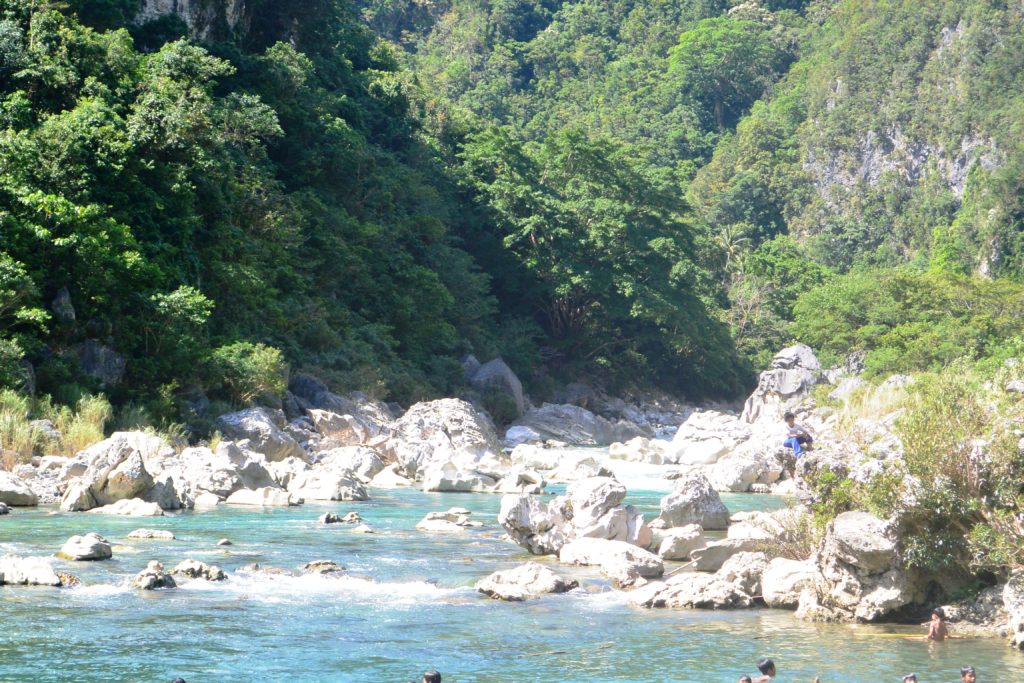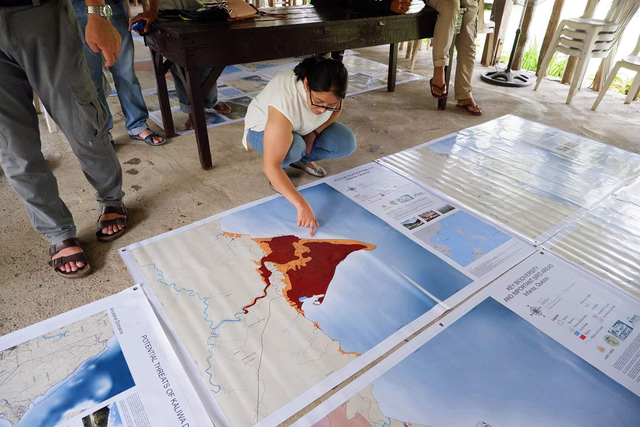
TINIPAK RIVER. This area – a favorite swim spot for tourists – will be gone and the Kaliwa Watershed Forest Reserve will be destroyed by the project. Photo by Irish Dominado
MANILA, Philippines – A Dumagat woman in Barangay Daraitan in Tanay, Rizal, was speaking before a group of visitors. Her blonde hair was neatly tied up. Her lips, red with lipstick. She said she didn’t look like a katutubo (tribe member). But she is, in her heart, through and through. Her name is Nila Grace Ouano, and she’s an Indigenous Peoples Mandatory Representative (IPMR) in Daraitan.
Her message? If no leader from the Dumagat-Remontado indigenous peoples (IPs) in Rizal would stand up for them, who would?
Daraitan will serve as the reservoir for the Kaliwa Dam. Construction is set to begin in July, if not August, even without the consent of their tribe and fellow IPs in General Nakar and Infanta in Quezon – the dam’s location.
Daraitan is part of their vast ancestral domain in the southern range of Sierra Madre, home to Mt. Daraitan, a famous mountaineering site along the borders of Tanay and Quezon Province.
She compared having a Certificate of Ancestral Domain Title (CADT) to renting an apartment: “You beautify and furnished it. But you know it isn’t yours. You have no assurance.”
But she made it clear that they’re not opposing the government, and what they want is a consideration of their rights. Now they’re calling for solidarity through a signature campaign supported by advocacy maps.
Advocacy maps show extent of impact
Pambansang Kilusan ng mga Samahang Magsasaka (PAKISAMA), Asian Farmers’ Association for Sustainable Rural Development, Land Matrix Initiative, and Philippine Association for Intercultural Development, together with the Agta-Dumagat-Remontado leaders in Rizal and Quezon, have developed advocacy maps to show how the areas will be affected.
A great part of Daraitan will be submerged, with half of the 428-hectare land area within the projected flood zone. It includes farms, trails to hiking sites, and residential and government facilities for over 5,000 residents.
John Francis Lagman, one of the participatory mapping facilitators of PAKISAMA, said communities by the river will need a longer bridge because they will be isolated. Sacred places will also be gone like the Tinipak River which is also a tourist attraction and a source of potable water.

FLOOD SUSCEPTIBILITY. A participant in the National Land Observatory Workshop looks at the flood-prone area in Infanta, Quezon. Photo by PAKISAMA
At least 5,000 IPs will be affected, along with their farms and hunting grounds.
For Infanta, the biggest effect will be on irrigation, aquifer, and sedimentation. As a delta, hindering the refill of sediments will cause the erosion of the ground and the eventual eradication of Infanta on the Philippine map, thus affecting 84,018 residents.
Lagman made it clear that the projected flood and drought zones in Nakar and Infanta will not be submerged or dried up, respectively, all at once. But he said natural phenomenon, coupled with the increase of water level or lack thereof as a result of the dam, should raise the alarm for concern.
A threat to resilience
This threat to their resilience happened before. When the Laiban Dam was partially built, they were prevented from planting and developing their land until hunger struck.
“Now that we have again nurtured our lands, there’s this new dam. It’s painful for us,” one of the Dumagat-Remontado tribe’s chieftains said.
Their plight is common with many IPs around the globe, despite being leaders in environmental protection.
Some 80% of the world’s biodiversity is in the IPs’ ancestral lands. These store nearly 300 billion metric tons of carbon or 33 times 2017’s global energy emissions, according to the Global Land Forum (GLF).
IPs with secure rights to their lands also have lower deforestation rates than government-protected lands, of which 40% is under the care of IPs.
According to Rights and Resources Initiatives’ (RRI) Alain Frechette, recognition and implementation of IPs’ rights is necessary for these communities to flourish and gain benefits from those rights.
Coincidentally, the First Nations of the Great Barrier Rainforest and Haida Gwaii is celebrating a decade of conservation finance through Coast Funds, which according to its director and board chair Merv Child “demonstrates how to link a healthy environment with the prosperity and well-being of indigenous peoples.”
In Daraitan and Quezon, there have been similar efforts through nongovernmental organizations and government projects. Now they have humble production houses for honey products, fruit wines, tea, and naturally dyed T-shirts, in addition to income derived from fruit-bearing plants and tourism.
When IPs’ rights are implemented and strengthened, people living beyond the Sierra Madre also benefit. We get a shield from strong typhoons. We get a healthy watershed. We get summits to hike, rivers to enjoy, and fresh food to eat. We get to preserve and nurture knowledge and traditions that understand the sacredness of our common home: nature.
This year, rights and how to create a global standard for the IPs’ land rights are the highlights of the yearly forum hosted by the GLF, “the world’s largest knowledge-led platform on integrated land use.”
Is it time we take a long look into conservation economy? After all, this is the gist of their call in Daraitan and Quezon: cheaper and viable alternatives to the dam.
Sign their petition to stop the Kaliwa Dam through this link. (Article by Mavic Conde, Rappler)




Comments are closed